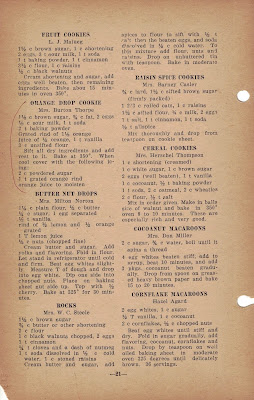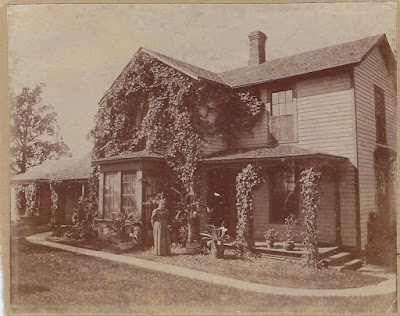I
want to share this article from The Algona Republican published December 30,
1874. It describes two different events
held on Christmas Eve that year sponsored by area churches. The first gathering was hosted by members of
the Universalist Society and the second was a joint venture between the
Methodist and Congregational churches.
In
those early days churches did not always have a permanent home and were used to
being somewhat mobile. According to the
History of Kossuth County published in 1913, the Universalist Church was first
organized here in 1873 by Rev. H. B. Butler and services were initially held in
the Baptist church.
The
Methodists were holding services in the chapel of Algona College in 1874 as it
would be some years before the beautiful church their congregation enjoys today
would be erected. Services of the
Congregational Church at that time were being convened in the old town hall
which they had purchased in 1868.
Neither facility would hold a crowd as large as the one expected for the
Christmas Eve celebration and so they joined forces to use the “hall” at the
new courthouse.
Santa’s
helpers were busy as the article discloses.
It is
safe to say that the last anniversary of Christmas-eve was celebrated by our
citizens with as much of solid, sensible mirth and enjoyment as any of its
predecessors. For several days our
merchants were kept busy from early morning till late at night, displaying
their Christmas wares, fanciful and substantial, for the inspection of the
numerous agents of Santa Claus. Truth to
tell, the amount of money expended in holiday gifts in Algona, this season,
exceeds the calculations of the most extravagant. Where all the money comes from is more than a
seven days’ wonder, and puzzles while it pleases the dealers. The rapid disappearance of holiday goods from
numerous show windows and cases was proof positive that many happy recipients
of favors were to be added to the list of admirers of the “jolly old elf,” the
children’s patron saint. On Thursday
there was a hurrying up and down in our streets. People of all ages and conditions, carrying
mysterious looking bundles, might have been seen at almost any hour in the day,
directing their steps to Court House Hall or the Universalist Church, where
their packages were deposited with as much of secrecy as the circumstances
would admit, preparatory to their display upon the Christmas-trees.
AT THE UNIVERSALIST CHURCH
The
late Fair given by the Universalist Society had so infringed upon the time and
taxed the energies of a majority of the members as to influence a decision
adverse to any unusual Christmas demonstration.
Nevertheless, the preparations for the evening were such as would have
done credit to any society at any time.
Two fine evergreen trees had been procured and were arranged very
tastefully, on each side the speaker’s platform, connected by garlands of
evergreen. These trees were heavily
laden with a profusion of St. Nicholas’ favors, from the smallest toy for the
little juvenile to the more valuable gift for the child of a larger
growth. Placed conspicuously over the
desk and between the tops of the trees was a representation of the Child
cradled in a manger. Over it rose and
set a beautiful star, whose evolutions continued during the evening. The exercises of the evening opened with a
prayer by Rev. Butler. This was followed
by singing and recitations by the children of the Sabbath School, after which
the distribution of gifts began. The
house was well filled by the friends, and nothing occurred to mar the pleasure
of the occasion.
 |
| Congregational Church - former Town Hall |
AT THE COURT HOUSE HALL
The
Methodist and Congregational Sabbath Schools had arranged for a union
celebration of the occasion at Court House Hall, and the result was probably
the grandest success ever achieved in that line in this part of the dominions
of Santa Claus. Court House Hall was
early in the evening crowded as never before, and before the exercises opened,
both the main floor and gallery were densely packed. We have no means of estimating the number of
those present, but the wonder was expressed on all sides as to where so many
people, of all ages, could have come from.
We were glad to see large numbers in from the country. The windows were brilliantly illuminated, and
the Hall gaily decorated, the latter being mostly the work of the ladies. Two large oak trees had been provided to bear
the gifts, and their wide spreading branches were heavily loaded. But the trees proved quite insufficient for
the purpose, and presents were deposited on tables in front of the speaker’s
platform, and stowed away around the foot of the trees, and in every available
place. The gifts were in good proportion
to the vast audience. The Cornet Band
was present and furnished several fine pieces of music while the audience was
being seated.
 |
| Kossuth County Courthouse built in 1872-73 |
The
following programme of exercises was carried out previous to the distribution
of presents:
Prayer by Rev. C. Taylor.
Singing by children.
Address by Milton Starr.
Song—“Ring Christmas Bells.”
Three-minute speech by Rev. Underwood.
Song—“Glory be to God on high.”
Rev. Webster declined to extend the
exercises by further remarks, and the task of distributing gifts was proceeded
with. It had been announced that Santa
Claus would be present and take a conspicuous part in the proceedings, but
other duties appear to have claimed his attention. The Committee showed themselves equal to the
emergency, and before a very late hour the tokens of love had been placed where
they would do the most good. The utmost
good feeling was preserved throughout the evening, and all seemed to thoroughly
enjoy the occasion.
At the conclusion of the exercises the
members of the Band were treated to an oyster supper at Hollar’s Restaurant.
As
I finished reading this article I couldn’t help but close my eyes and picture
the hustle and bustle of downtown Algona during the Christmas holidays in
1874. In my imagination I see sleighs or
wagons with their horses tied to hitching posts while owners shop or gather
around a warm stove for a cup of coffee and gossip with their neighbors; stores
of various sizes and construction with holiday gifts and displays in their
windows to entice window shoppers to come inside; and the crowd gathered inside
of the new courthouse near two oak trees covered in gifts while children sing
carols. And it warms my heart to know,
even back then, they had numerous “agents of Santa Claus” who, because of their
generosity, made sure that area families had a blessed and joyous Christmas.
And
that is my wish for you, dear readers.
May your every wish come true!
Until
next time,
Kossuth
County History Buff
If
you enjoyed this post, please don’t forget to “like” and SHARE to Facebook. Not
a Facebook user? Sign up with your email address in the box on the
right to have each post sent directly to you.
Be
sure to visit the KCHB Facebook page for more interesting info about the
history of Kossuth County, Iowa.
Reminder: The
posts on Kossuth County History Buff are ©2015-2019 by Jean Kramer. Please
use the FB “share” feature instead of cutting/pasting.

























